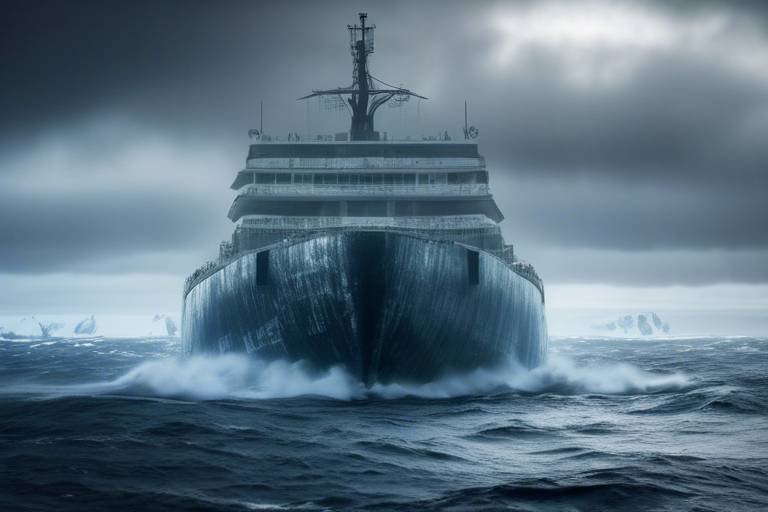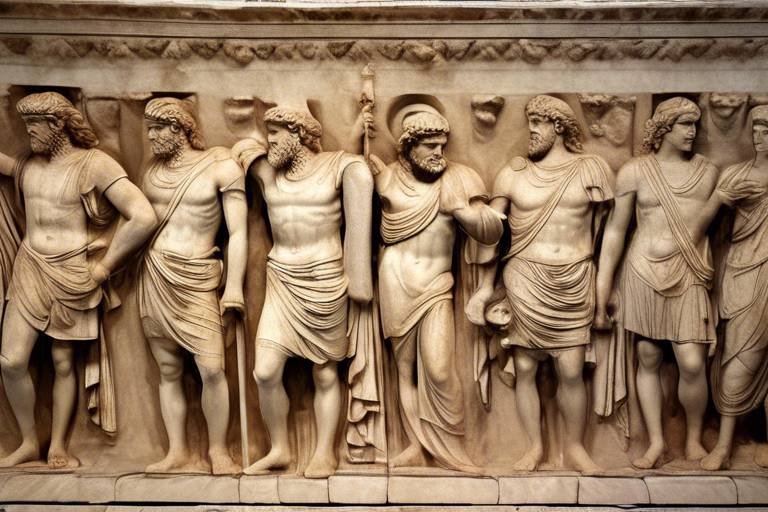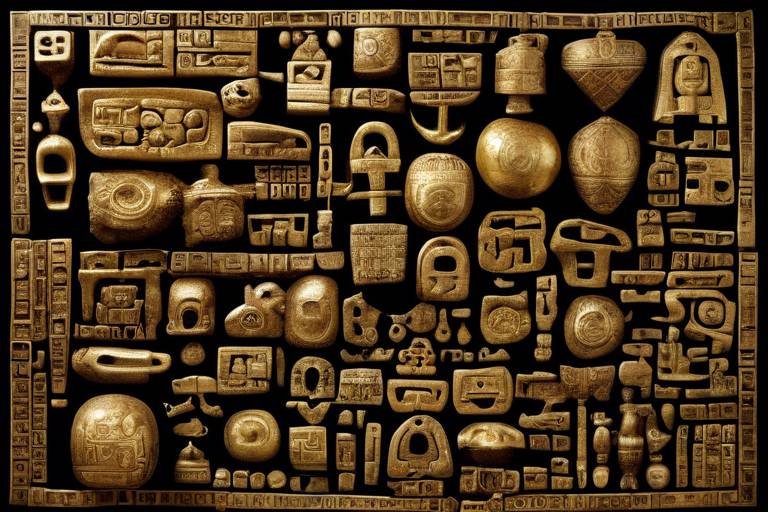The Mystery of the Lost Civilizations of the South Pacific
Embark on a journey through time and unravel the enigmatic disappearance of ancient civilizations in the South Pacific region. The lush tropical landscapes of the South Pacific hold secrets of lost societies waiting to be discovered. Archaeological puzzles scattered across the islands offer glimpses into a rich history shrouded in mystery and intrigue.
Imagine standing amidst the remnants of once-thriving civilizations, pondering the fate of those who built magnificent structures and left behind tantalizing clues. The South Pacific beckons with tales of forgotten empires and vanished cultures, inviting exploration into the depths of time.
From the intricate megalithic structures of Easter Island to the submerged city of Nan Madol in Micronesia, each archaeological site paints a vivid picture of ancient ingenuity and cultural richness. The petroglyphs of Samoa whisper stories of bygone eras, while the myth of the lost continent of Mu lingers in the collective imagination.
As we delve into the mysteries of the Marquesas Islands and unearth recent discoveries in Fiji, a tapestry of lost civilizations begins to take shape. The legacy of the Lapita people, early seafaring settlers of the Pacific, leaves an indelible mark on the region, connecting us to our ancient past in profound ways.

Polynesian Navigation Techniques
Exploring the vastness of the Pacific Ocean, ancient Polynesians developed remarkable navigation techniques that allowed them to sail thousands of miles across open waters, connecting distant islands with astonishing precision. At the heart of their navigation prowess lay a deep understanding of the natural world, celestial bodies, and ocean currents. By observing the stars, sun, moon, and patterns of marine life, Polynesian navigators could chart their course without the need for modern instruments.
One of the key techniques employed by Polynesian seafarers was the art of wayfinding, a complex system of orientation and navigation that relied on environmental cues and mental maps rather than written charts. By memorizing the positions of stars and swells, feeling the subtle changes in wind direction, and interpreting the behavior of birds and marine life, they could determine their location and direction at sea.
Moreover, Polynesians used a technique known as "dead reckoning," estimating their position based on factors such as speed, time traveled, and direction taken. This method required exceptional mental calculations and a deep connection to the natural world, allowing navigators to maintain a sense of their whereabouts even in the absence of visible landmarks.
Through the combination of celestial navigation, wayfinding, and dead reckoning, Polynesians were able to embark on daring voyages across the Pacific, discovering and settling remote islands such as Hawaii, New Zealand, and Tahiti. Their navigational achievements not only shaped the cultural landscape of the region but also demonstrated the ingenuity and resilience of ancient seafaring civilizations.

Megalithic Structures of Easter Island
The Megalithic Structures of Easter Island stand as a testament to the ancient engineering prowess and cultural sophistication of the island's inhabitants. These iconic moai statues, with their enigmatic expressions and imposing presence, have captivated the imagination of archaeologists and visitors alike. Carved from volcanic tuff, these monolithic figures are believed to represent ancestors or important tribal figures, each bearing unique facial features and symbolic significance.
One of the most intriguing aspects of the megalithic structures on Easter Island is the method of their transportation and erection. How did a society with limited resources and technology manage to move these massive statues, some weighing up to 80 tons, across the island? Theories range from the use of log rollers, ropes, and manpower to more elaborate explanations involving the use of sledges and even a form of upright walking known as "parbuckling."
Furthermore, the intricate stone platforms known as ahu, on which the moai are mounted, serve as ceremonial and burial sites, adding another layer of mystery to the purpose and rituals surrounding these enigmatic monuments. The alignment of the statues with the horizon and celestial bodies suggests a deep understanding of astronomy and spiritual beliefs, highlighting the complex worldview of the ancient Rapa Nui civilization.
Visitors to Easter Island are not only struck by the sheer scale and number of the moai but also by the sense of isolation and mystery that permeates the landscape. The enigmatic aura surrounding these megalithic structures invites contemplation on the lost civilization that created them and the secrets they hold about the island's past.

The Sunken City of Nan Madol
The Sunken City of Nan Madol is a fascinating archaeological site located in Micronesia, characterized by its unique construction on a series of artificial islets. This ancient city, often referred to as the Venice of the Pacific, showcases the advanced architectural skills of its builders, who meticulously stacked massive basalt columns to create intricate structures. The sheer scale and complexity of Nan Madol's design continue to baffle researchers and visitors alike, offering a glimpse into the ingenuity of the civilization that once thrived in this remote corner of the world.
The origins of Nan Madol date back to the 8th century AD, with the city believed to have served as a political and religious center for the ruling elite. The interconnected islets, canals, and basalt walls of Nan Madol stand as a testament to the engineering prowess of its builders, who managed to create a complex network of structures in the midst of the Pacific Ocean. The significance of Nan Madol lies not only in its architectural marvels but also in the mysteries surrounding its purpose and eventual abandonment, adding to the allure of this sunken city.
Exploring Nan Madol today offers a glimpse into a lost civilization that once thrived in harmony with the natural landscape. The intricate layout of the city, with its ceremonial platforms, tombs, and residential areas, provides valuable insights into the social structure and religious practices of the ancient Micronesian society. As visitors navigate the waterways and moss-covered ruins of Nan Madol, they are transported back in time to a bygone era, where the echoes of a once-vibrant civilization still resonate beneath the waves.

Mysterious Petroglyphs of Samoa
Samoa, a picturesque archipelago in the South Pacific, is shrouded in mystery and intrigue, with its ancient petroglyphs scattered like cryptic messages across the islands. These mysterious rock carvings, etched into the rugged landscapes of Samoa, offer a glimpse into the enigmatic world of the island's past inhabitants. The petroglyphs, created by the skilled hands of ancient Samoans, depict a variety of symbols, figures, and patterns that hold profound cultural and spiritual significance.
Stepping into the realm of these petroglyphs is like unraveling a puzzle left behind by a long-lost civilization. Each intricate carving tells a story, preserving the memories, beliefs, and traditions of a people long gone. The petroglyphs serve as a window into the daily life, rituals, and cosmology of the ancient Samoans, offering a unique perspective on their worldview and connection to the natural world.
One of the most fascinating aspects of the petroglyphs is their sheer diversity and complexity. From geometric patterns to human figures, marine life to celestial symbols, the range of motifs found in Samoa's rock art is truly mesmerizing. The intricate details and expert craftsmanship displayed in these carvings speak to the artistic prowess and spiritual depth of the ancient Samoan culture.
As the sun sets over the rugged cliffs and lush valleys of Samoa, the petroglyphs come alive, casting shadows that dance with the whispers of a bygone era. Visitors to the islands are captivated by the enigmatic allure of these ancient artworks, pondering the meanings behind the symbols and the stories they hold. The petroglyphs of Samoa stand as silent witnesses to a lost civilization, inviting us to unlock their mysteries and delve into the rich tapestry of the island's past.

Lost Civilization of Mu
The Lost Civilization of Mu has long been a subject of fascination and speculation among historians, archaeologists, and enthusiasts of ancient mysteries. According to certain theories, Mu was a vast continent that supposedly existed in the Pacific Ocean thousands of years ago, before sinking into the depths of the sea. While the existence of Mu remains a topic of debate and skepticism in the scientific community, the concept of this mythical land continues to capture the imagination of many.
Proponents of the Mu civilization suggest that it was a highly advanced society with sophisticated technology and cultural achievements far ahead of its time. Legends and folklore from various Pacific cultures hint at a grand civilization that met a catastrophic end, leaving behind only fragmented clues and enigmatic stories passed down through generations.
One of the most prominent theories surrounding Mu is its potential connection to other lost civilizations in the South Pacific, such as those of Easter Island, Nan Madol, and other mysterious archaeological sites scattered across the region. Some researchers speculate that these ancient cultures shared knowledge, trade routes, and possibly even a common ancestry, forming a complex network of interactions that shaped the history of the Pacific islands.
Despite the lack of concrete evidence supporting the existence of Mu as a physical landmass, the allure of this enigmatic civilization persists in popular culture and historical debates. Whether viewed as a myth, a metaphor, or a genuine historical entity, the Lost Civilization of Mu continues to spark curiosity and inspire exploration into the mysteries of the South Pacific's ancient past.

The Enigma of the Marquesas Islands
The Marquesas Islands, located in the remote reaches of the South Pacific, are shrouded in mystery and intrigue, captivating the imagination of adventurers and historians alike. These enigmatic islands boast a rich cultural heritage and a history that is as complex as it is fascinating.
One of the most striking features of the Marquesas Islands is their intricate art, which adorns everything from ancient stone carvings to traditional tattoos. The art of the Marquesan people is a window into their beliefs, traditions, and way of life, offering a glimpse into a world that is both ancient and enduring.
Moreover, the unique language spoken in the Marquesas Islands is a testament to the isolation of these remote lands. The linguistic mysteries of the Marquesan dialects hint at a past that is as enigmatic as the islands themselves, with connections to distant cultures and ancient migrations.
Exploring the Marquesas Islands reveals a tapestry of cultural practices and rituals that have been passed down through generations, preserving the essence of a civilization that has weathered the test of time. From traditional dances to elaborate ceremonies, the customs of the Marquesan people speak to a heritage that is as vibrant as it is enigmatic.
As you traverse the rugged landscapes and lush valleys of the Marquesas Islands, you can't help but feel the echoes of a past that is both distant and ever-present. The enigma of these islands lies not only in their physical beauty but also in the stories they hold, waiting to be uncovered and shared with the world.

Archaeological Discoveries in Fiji
Archaeological Discoveries in Fiji reveal a fascinating glimpse into the ancient cultures that once thrived on this tropical island nation. Recent excavations have unearthed a treasure trove of artifacts, burial sites, and settlements that offer valuable insights into the history and lifestyle of the prehistoric Fijian people.
One of the most significant discoveries in Fiji is the ancient Lapita pottery, which provides evidence of the early seafaring settlers who first arrived in the region around 1500 BCE. These skilled potters left behind intricate ceramics adorned with intricate geometric designs, showcasing their advanced craftsmanship and artistic abilities.
Excavations at various sites across Fiji have also revealed elaborate burial grounds, where archaeologists have uncovered human remains adorned with jewelry and ceremonial objects. These findings shed light on the burial practices and social structure of the ancient Fijian societies, highlighting their reverence for the deceased and belief in an afterlife.
Furthermore, the discovery of stone tools and implements used for fishing, hunting, and farming provides valuable information about the daily life and subsistence strategies of the early Fijian inhabitants. These artifacts offer a glimpse into the technological advancements and resourcefulness of these ancient cultures, showcasing their ability to adapt to the island environment.
Through careful excavation and analysis of these archaeological finds, researchers continue to piece together the puzzle of Fiji's prehistoric past, unraveling the mysteries of the ancient civilizations that once thrived in this lush and fertile archipelago.

The Legacy of the Lapita People
The legacy of the Lapita people, early seafaring settlers of the Pacific, is a fascinating chapter in the history of the region. These skilled navigators and artisans, believed to have originated from the islands of Southeast Asia, embarked on daring voyages across vast stretches of ocean, eventually reaching the remote reaches of the Pacific.
The Lapita culture is renowned for its distinctive pottery adorned with intricate geometric designs, showcasing their artistic prowess and cultural sophistication. These finely crafted artifacts not only serve as archaeological treasures but also as a testament to the creativity and ingenuity of the Lapita people.
Furthermore, the legacy of the Lapita extends beyond their artistic achievements. Their seafaring expertise allowed them to establish settlements in diverse locations, influencing the development of subsequent Pacific cultures. The Lapita's agricultural practices, social organization, and linguistic influences have left a lasting imprint on the indigenous peoples of the Pacific.
Archaeological excavations have unearthed evidence of Lapita settlements across the Pacific islands, providing valuable insights into their daily lives, rituals, and technological advancements. The Lapita's navigational skills and trade networks facilitated the exchange of goods, ideas, and cultural practices, shaping the interconnectedness of the region.
In conclusion, the legacy of the Lapita people stands as a testament to the resilience, adaptability, and creativity of ancient Pacific civilizations. Their contributions to art, navigation, and cultural exchange have enriched the tapestry of Pacific history, highlighting the enduring impact of this remarkable seafaring culture.
Frequently Asked Questions
- What are some theories about the disappearance of ancient civilizations in the South Pacific?
Various theories suggest factors such as environmental changes, warfare, or cultural shifts may have contributed to the decline of these civilizations. The exact reasons remain a subject of ongoing research and debate among archaeologists.
- How did ancient Polynesians navigate the vast ocean without modern technology?
Ancient Polynesians utilized a combination of celestial navigation, knowledge of ocean currents, bird migration patterns, and natural signs like wave patterns to navigate the open seas. Their navigational skills were highly advanced and allowed them to colonize distant islands.
- What is the significance of the moai statues on Easter Island?
The moai statues are believed to represent ancestral chiefs or important figures in the society of Easter Island. They are considered both religious and political symbols, reflecting the cultural and spiritual beliefs of the ancient Rapa Nui people.
- What makes Nan Madol in Micronesia a unique archaeological site?
Nan Madol is distinctive for its complex series of artificial islets made of basalt and coral boulders. The city's construction on these islets showcases the advanced engineering skills of its builders and raises questions about the purpose and organization of the site.
- How do petroglyphs in Samoa provide insights into ancient life?
The petroglyphs found in Samoa depict various aspects of daily life, religious beliefs, and cultural practices of the ancient Samoan people. These rock carvings offer valuable clues to understanding the social structure and artistic expressions of the past.


















